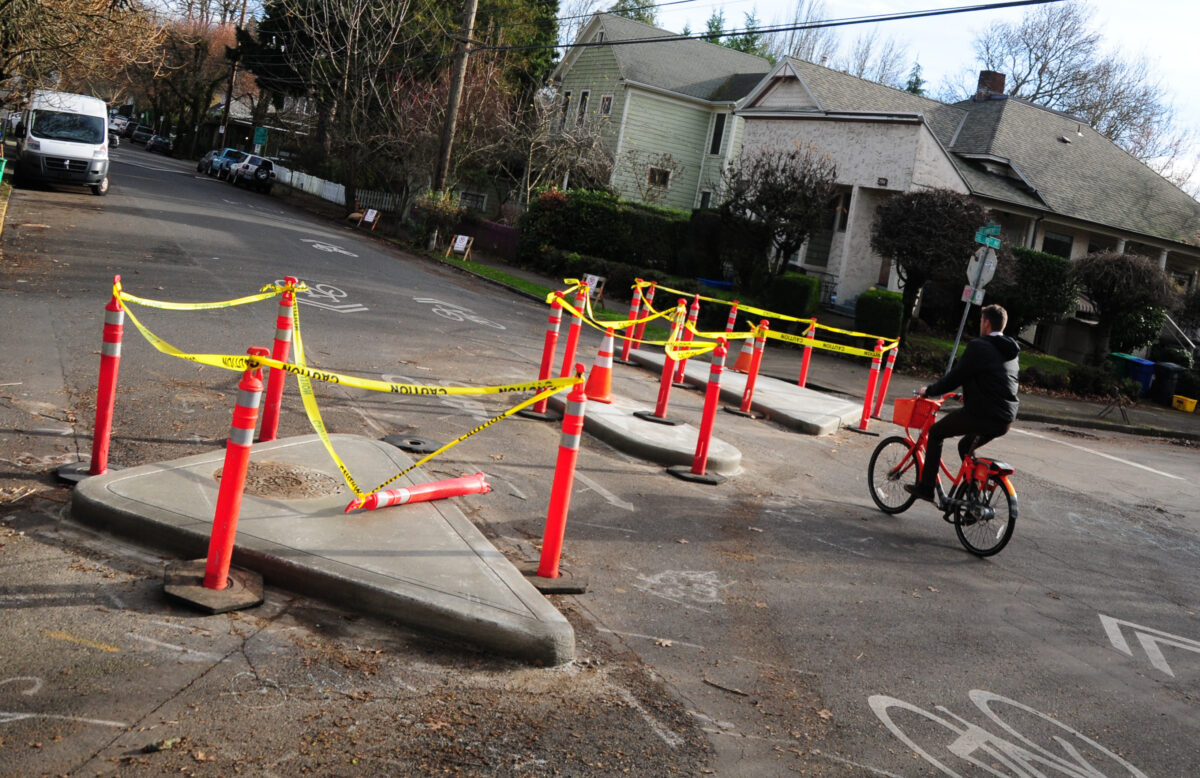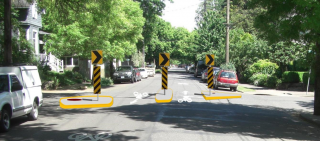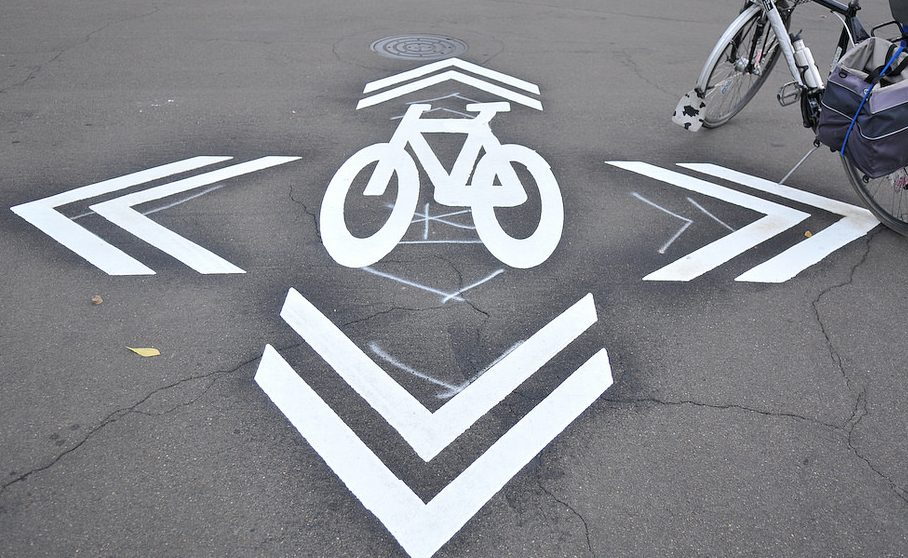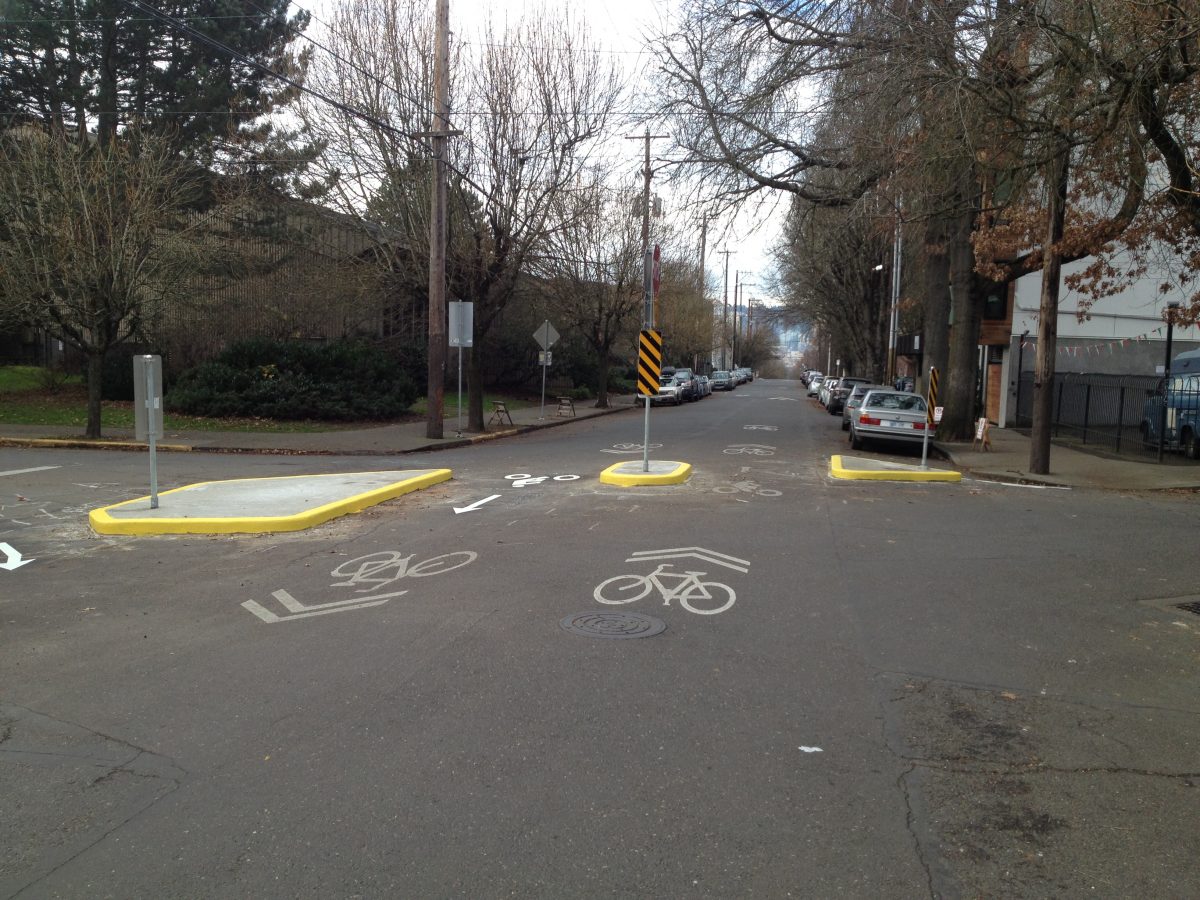
(Photos: Jonathan Maus/BikePortland)
“Things have changed a lot since we did our neighborhood greenway assessment [in 2015]… There’s more traffic pressure.”
— Roger Geller, PBOT
Life is slowly but surely getting harder for people who drive in Portland. And that’s exactly what the Bureau of Transportation is aiming for. In the past week they’ve laid down median diverters that limit where we can drive. The goal is to encourage us to keep our cars off what are known as neighborhood greenways — streets where cycling is supposed to be the priority mode of travel.
But as Portland’s roads have become filled with too many drivers in recent years, PBOT has had to do more to defend greenways from an onslaught of traffic-dodgers staring into Waze and Google Map apps in an attempt to shave a few seconds off their trip. Unfortunately those apps often lead people onto (what should be quiet) side streets that have been engineered specifically to make cycling less stressful. To end this cycle of more drivers and more stressful conditions on side streets, PBOT has added new diverters at two locations: on SE Ankeny at 15th and SE 50th at Lincoln.
SE Ankeny and 15th


As we reported in 2014, many drivers swoop onto Ankeny to avoid the traffic further west at the Burnside/Couch couplet. Thanks to activists with Bike Loud and Buckman neighborhood residents, PBOT agreed to install a temporary diverter at 15th. They made good on their promise in July 2016 by placing large concrete planters and yellow caution signs in the middle of the intersection. The treatment prevented people from driving straight through 15th, forcing westbound drivers to turn north (back to Burnside) and eastbound drivers south.
This week PBOT made those temporary diverters permanent by laying down concrete median islands. The new islands are easier on the eye and are intended to accomplish the same result. PBOT told us this morning that more signage and vertical elements are still to come. They include (but are not limited to): stop signs facing north and south, yellow warning signs that alert people to the presence of people biking through the intersection, yellow and black striped sign, and signage leading up to the intersection indicating that it’s not for through-traffic, only bicycle traffic.
SE Lincoln and 50th

It’s been a year since the infamous open house where opposition to the Lincoln-Harrison neighborhood greenway project went absolutely off-the-rails. PBOT’s attempts to reduce the amount of driving on Lincoln were met with epic opposition. Ultimately PBOT won the day with a revised plan that came out in March.
One of the biggest sticking points was a diverter at 50th and Lincoln. PBOT had to do something because this intersection had the highest volume of drivers of anywhere on the greenway — 2,300 cars per day east west of 50th and 1,500 east of it. The city’s goal for greenways is under 1,000 cars per day.
They settled on a compromise design that would place diverters in the middle of 50th to prevent people from driving through the intersection and limit some turning movements.
Advertisement
Work began this week to install the diverter. However, some activists are crying foul because PBOT has altered the design since it was last shown to the public.

On Tuesday, local resident Andrea Brown with the Safer Lincoln group emailed PBOT Capitol Project Manager Sheila Parrott. Brown was concerned that the new design, “Has created an unsafe jog in the bicycle flow in order to accommodate an extraneous parking space on the northeast corner.” Brown added that her group was aware that an adjacent neighbor had contacted PBOT to request a parking spot in front of their house (which has its own driveway).
Parrott wrote to Brown that, “Following resident input, we revised the plan to remove the on-street parking on the south side and provide a disabled parking space on the north side. Although this type of parking space is generally used by the person making the request for the space, it is not a personal space. Anyone displaying the disabled placard can use the space.”
Another transportation activist and local resident named Betsy Reese emailed PBOT with several concerns about the new design. One problem she mentioned was that it, “Forces westbound cyclists to veer to the left to get past a stopped car, then veer to the right to line up at the gap in the diverter.” Reese wanted the parking spot moved further east to avoid conflicts at the intersection.
A PBOT traffic engineer replied to Reese to say the current layout is only a prototype and they plan to monitor her concerns as part of the evaluation
A brand new greenway treatment

In other neighborhood greenway news, PBOT unveiled a new idea at the Bicycle Advisory Committee meeting on Tuesday night. Citing what he sees as, “more traffic pressure” on neighborhood greenways since PBOT’s assessment report was passed by council in August 2015, PBOT bicycle program manager Roger Geller said they’re considering a new approach. Geller shared a list of projects up for possible funding in 2019-2020 that included one described as, “An innovative attempt to highlight the visibility of bicycle priority on neighborhood greenways.” The idea is to double the frequency of sharrow markings, possibly add painted stop lines on side streets, and add other signage as needed.
Geller said he’s noticed that many people ride in the door-zone on neighborhood greenways — a sign of stress likely caused by fears of drivers coming from behind. Geller wants to make Portland greenways more “readable as a bikeway.” In addition to more sharrows and signage, he’d like couple that with an education program. The goal would be to make it more difficult for people in cars to pass bicycle users, which would hopefully discourage people from driving on greenways altogether.
UPDATE: Reader 9watts (who’s concerned about the width of the biking gaps being too wide) has sent us fresher photos of the Ankeny/15th diverters:
— Jonathan Maus: (503) 706-8804, @jonathan_maus on Twitter and jonathan@bikeportland.org
Never miss a story. Sign-up for the daily BP Headlines email.
BikePortland needs your support.




